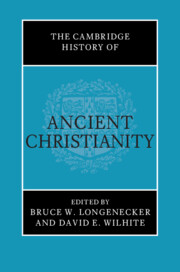Book contents
- The Cambridge History of Ancient Christianity
- The Cambridge History of Ancient Christianity
- Copyright page
- Contents
- Figures
- List of Contributors
- Editors’ Preface
- Part I Contested Contexts
- Part II Contested Figures
- Part III Contested Heritage
- 9 Jews and Christians in Pagan Antiquity
- 10 The Marcionite Option
- 11 The Gnostic Options
- 12 Early Christian Involvement in Classical Education, Literature, and Philosophy
- 13 Scriptures and Interpretations in Early Christian History
- Part IV Contested Cultures
- Part V Contested Beliefs
- Part VI Contested Bodies
- Ancient Sources
- Modern Authors
- References
12 - Early Christian Involvement in Classical Education, Literature, and Philosophy
from Part III - Contested Heritage
Published online by Cambridge University Press: 23 August 2023
- The Cambridge History of Ancient Christianity
- The Cambridge History of Ancient Christianity
- Copyright page
- Contents
- Figures
- List of Contributors
- Editors’ Preface
- Part I Contested Contexts
- Part II Contested Figures
- Part III Contested Heritage
- 9 Jews and Christians in Pagan Antiquity
- 10 The Marcionite Option
- 11 The Gnostic Options
- 12 Early Christian Involvement in Classical Education, Literature, and Philosophy
- 13 Scriptures and Interpretations in Early Christian History
- Part IV Contested Cultures
- Part V Contested Beliefs
- Part VI Contested Bodies
- Ancient Sources
- Modern Authors
- References
Summary
Ancient Christianity’s relationship to classical education, literature, and philosophy is oddly tense. To be sure, Christianity originated in a thoroughly Hellenized cultural context in which literary-rhetorical education (paideia)1 was not only a lofty humanistic ideal2 but an essential prerequisite for the functioning of society.3 It existed not only for the social, political, and economic elites in metropolitan centers; members of lower social strata in the provinces, women as well as men, had a stake in it, too. During the first and second centuries ce, Galilee and Judea, the regions where Christianity can be said to have originated, were thoroughly part of that world.4
- Type
- Chapter
- Information
- The Cambridge History of Ancient Christianity , pp. 276 - 297Publisher: Cambridge University PressPrint publication year: 2023



